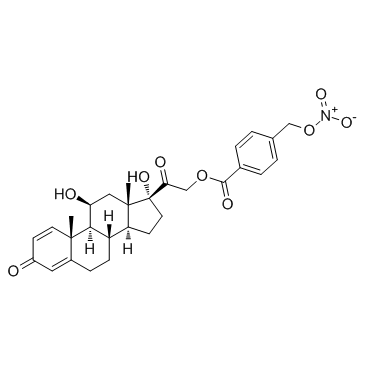| Description |
NO-prednisolone is a nitric oxide (NO)-releasing derivative of Prednisolone. NO-prednisolone potently stimulates IL-10 production in vivo.
|
| Related Catalog |
|
| Target |
IL-10[1]
|
| In Vitro |
NO-prednisolone (NCX-1015), an NO-releasing derivative of Prednisolone, is demonstrated to be more effective than Prednisolone in reducing inflammation, inhibiting cytokine and chemokine generation, and up-regulating the expression of the steroid-sensitive cell-surface marker CD163 in human peripheral blood mononuclear cells[1] Incubation of PBMCs with NO-prednisolone (NCX-1015) and Prednisolone produces a concentration-dependent activation of CD163. NO-prednisolone is more potent than Prednisolone at inducing CD163 cell surface expression. The increased efficacy of NO-prednisolone, compared with the parent molecule Prednisolone, is also observed when assessing inhibition of LPS induced IL-1β production[2].
|
| In Vivo |
In vivo treatment with NO-prednisolone (NCX-1015) potently stimulates IL-10 production, suggesting that the NO steroid induces a regulatory subset of T cells that negatively modulates intestinal inflammation. The two doses of NO-prednisolone tested, 0.5 and 5 mg/kg/day (equivalent to 0.33 and 3.3 mg/kg/day prednisone, respectively) effectively attenuates the severity of the wasting syndrome, ameliorates the colitis score, and reduces the colonic myeloperoxidase (MPO) activity. NO-prednisolone administration also reduces the colonic mRNA and protein content of tumor necrosis factor-α, IL-12, and IFN-γ. NO-prednisolone also reduces the expression of inducible NO synthase and cyclooxygenase-2 but in contrast does not inhibit colonic expression of IL-10 mRNA or protein. In fact, IL-10 expression is enhanced in mice treated with NO-prednisolone[1].
|
| Kinase Assay |
Peripheral blood mononuclear cells (PBMCs) are isolated from heparinized human whole venous blood using Ficoll-Hypaque (d=1.077 g). PBMCs are then washed three times with HEPES buffered RPMI 1640 containing 0.05% gentamycin and 10% donor serum. Cells (1×106, ~20% monocytes, the remainder having been lymphocytes) are transferred to a 48 well plate and pre-incubated for 1 h with Prednisolone, NO-prednisolone (10 μM-0.1 nM) or vehicle, followed by activation with LPS (1 μg/mL) for 24 h at 37°C and 5% CO2. Supernatants are removed and IL-1β production measured using a commercially available human IL-1β ELISA[2].
|
| Animal Admin |
Mice[1] BALB/c and male Swiss Albino mice (6-8 weeks old) are used. Mice (12 per group) are injected intrarectally with 50% ethanol or 1, 1.5, 2, or 2.5 mg per mouse of TNBS. TNBS-treated mice then are treated s.c. with 5 mg/kg/day Prednisolone or NO-prednisolone for 7 days. Surviving mice are killed 8 days after TNBS administration, colonic inflammation is scored, and myeloperoxidase (MPO) activity is measured. After instillation of 1.5 mg per mouse of TNBS, animals are allocated randomly into one of three treatment groups [placebo, NO-prednisolone (5 or 0.5 mg/kg/day s.c.), or Prednisolone (10 or 5 mg/kg/day s.c.)] and followed for 7 days. Mice are monitored for the appearance of diarrhea, loss of body weight, and overall mortality. At the end of the experiment, surviving mice are killed, blood samples are collected by cardiac puncture, and a 7 cm segment of the colon is excised for macroscopic and microscopic damage evaluation. Colonic IL-2, IL-10, IFN-γ, and tumor necrosis factor-α (ELISA and RT-PCR) and MPO activity are assessed according to published methods. In duplicate experiments, the colons of surviving mice are excised for LPMC preparation.
|
| References |
[1]. Fiorucci S, et al. NCX-1015, a nitric-oxide derivative of prednisolone, enhances regulatory T cells in the lamina propria and protects against 2,4,6-trinitrobenzene sulfonic acid-induced colitis in mice. Proc Natl Acad Sci U S A. 2002 Nov 26;99(24):15770-5. [2]. Paul-Clark M, et al. 21-NO-prednisolone is a novel nitric oxide-releasing derivative of prednisolone with enhanced anti-inflammatory properties. Br J Pharmacol. 2000 Dec;131(7):1345-54.
|
